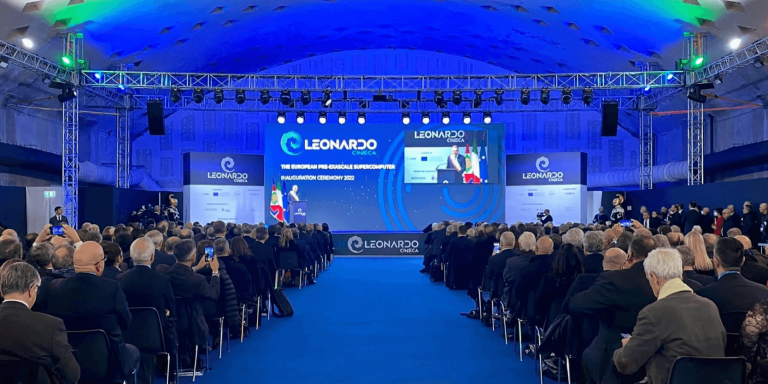
On Thursday, November 24, EuroHPC, the European High Performance Computing Joint Undertaking, the Italian Ministry of Education, Universities and Research and CINECA, the Inter-University Consortium for Automatic Computing in Northeastern Italy, officially inaugurated LEONARDO, the latest EuroHPC pre-exaflop supercomputer ranked as the 4th fastest in the world, at the Bologna Technology Park in Italy.
The EuroHPC Joint Undertaking is a legal and financial entity created in 2018 to enable the EU and EuroHPC participating countries to coordinate their efforts and pool their resources with the aim of making Europe a world leader in high-performance computing.
To date, five of its supercomputers are operational: LUMI in Finland (which ranks 3rd in the world), Vega in Slovenia, MeluXina in Luxembourg, Discoverer in Bulgaria, and Karolina in the Czech Republic, three are being installed: Deucalion in Portugal, MareNostrum5 in Spain and LEONARDO in Italy. Other systems are planned in the short term.
Leonardo, fourth in the Top 500 supercomputers
Frontier from Oak Ridge National Laboratory in Tennessee leads the ranking, followed by Fugaku from the Riken Center for Computational Science in Japan. LUMI maintains its third place ahead of LEONARDO.
EuroHPC and the Italian Ministry of Education, Universities and Research have jointly contributed to its €120 million funding. The Leonardo consortium, led by Italy, is composed of six countries: Austria, Greece, Hungary, Italy, Slovenia and Slovakia.
The LEONARDO system is based on the BullSequana XH2000 solution provided by Atos, with Xeon Platinum 8358 32C 2.6 GHz as main processors, NVIDIA A100 SXM4 40 Gb as gas pedals, Quad-rail NVIDIA HDR100 Infiniband for the interconnection. It is particularly suited for high-intensity computing tasks such as AI, machine learning, data processing, and high-performance data analysis (HPDA). It is hosted by CINECA at the Technopole of Bologna in Italy.
Currently, Leonardo is capable of running more than 174 petaflops, or more than 174 million billion calculations per second. It is expected to become fully operational in the first half of 2023 with an expected performance of 250 petaflops. Half of the Leonardo computing resources will be allocated to EuroHPC users, following periodic peer-reviewed open calls in which all eligible European users will be able to participate.
Like all EuroHPC supercomputers, LEONARDO uses a water cooling system to improve energy efficiency and is equipped to adjust its power consumption to ensure a balance between energy savings and performance in an environmentally friendly manner.
The LEAP program
It will first be available through LEAP, the Early Access Program for its resources. A call for projects was launched at the beginning of the month, aimed at projects with a high scientific impact and the ability to exploit a very large availability of computing resources. Open to all sectors of science, industry and the public sector, the APP will close at the end of the month.
Selected project proponents will be able to take advantage of the full computing power of Leonardo’s Booster module, equipped with 3456 compute nodes, each provided with four NVIDIA Ampere-based GPUs driven by a single Intel Ice Lake 32 processor core, during the pre-production phase, scheduled to run from the beginning of January to the end of March 2023. This phase will test the functionality of the machine at full capacity.
Translated from Inauguration de LEONARDO, supercalculateur de classe mondiale de l’entreprise EuroHPC JU









